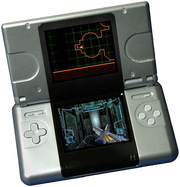Template:System The Nintendo DS (ニンテンドーDS, Nintendō Dīesu) is the first in Nintendo's latest series of handheld systems. Its major features include its two screens, one of which is a touch screen, a built-in microphone, and wireless capabilities allowing for multiplayer games and applications. Since its release in 2004, the Nintendo DS has seen great consumer success amongst the several versions of itself.[1]
History
It was originally stated that a new system was being developed on November 13, 2003, though no details were announced. On January 20, 2004, however, the system was announced with "Nintendo DS" being its codename - again, with minimal details. Later on, the codename was changed to "Nitro", but changed back when the system was shown at E3 2004; the "Nitro" codename can still be seen in the product codes for all Nintendo DS-related items, such as the system's code itself: "NTR-001". The system shown at E3 was an older version of the system, much blockier and the existing version of the standard system which was shown on July 28, 2004, when the name was officially said to be finalized as "Nintendo DS".
The Nintendo DS was released in North America on November 21, 2004, at US$149.99, with a demo version of the later-released Metroid Prime Hunters bundled. The Japanese release took place two weeks later on December 2, and later in other regions.
Features
Dual Screens
The Nintendo DS has twin 3-inch backlit color liquid crystal displays. The lower display is touch sensitive and is operated with a stylus. The upper panel has stereo speakers on either side of the upper display. The lower screen's touch capability is utilized in most games, and many games utilize it as the primary, and sometimes only, method of control, as seen in Phantom Hourglass or Nintendogs.
Stylus
The stylus is a pen-like object for use with the Nintendo DS and its touch screen. In games most known as Touch Generation Games, the player can play most, if not all, of the game without using any of the system's buttons, but just using the stylus. Nintendo has released several customized styli for specific games, with the styli being made with Mario, Pokemon or Zelda designs.
Wireless
The system comes with built-in 802.11 wireless capabilities, allowing the system to link with other systems for multiplayer games and applications, such as the system's built-in PictoChat. The wireless also allows the system to connect to the Internet and take advantage of the Nintendo Wi-Fi Connection, Nintendo's online gaming service, allowing for Internet play of many of the Nintendo DS' games.
Other Features
The system features a microphone which can be used to pick up various sounds for whatever function the game developer chooses to use it for, be it voice-recognition (as seen in Nintendogs), voice chat (as seen in Metroid Prime Hunters), or many other potential applications.
It also features an extra game slot capable of playing Game Boy Advance games. Game Boy and Game Boy Color games are incompatible due to size issues, but the slot is also utilized for certain games that feature extra add-ons such as a Rumble Pak. All of this is run on a single rechargeable lithium ion battery, allowing for up to 10 hours of gameplay on a 3 to 4 hour charge.
Phantom Hourglass makes use of the DS internal clock. Certain events will take place at midnight according to the internal clock of the system.
The Legend of Zelda games
So far there have been five Zelda games released on the Nintendo DS. Two main series Zelda games; Phantom Hourglass and Spirit Tracks and three spin off series games; Freshly-Picked Tingle's Rosy Rupeeland, Tingle's Balloon Fight DS, and Color Changing Tingle's Love Balloon Trip. Phantom Hourglass was the first DS Zelda game to be released in North America and Australia, while Tingle's Rosy Rupeeland was released first in Japan and Europe.
With the DS's compatibility with Game Boy Advance games, several other Zelda games can be playable on the DS including the Nintendo Entertainment System versions of The Legend of Zelda, The Adventure of Link, and A Link to the Past.
Games released for the Nintendo DS:
- Phantom Hourglass
- Freshly-Picked Tingle's Rosy Rupeeland
- Tingle's Balloon Fight DS
- Color Changing Tingle's Love Balloon Trip
- Spirit Tracks
See Also
References
- ↑ Consolidated Financial Highlights Retrieved on October 15, 2008

